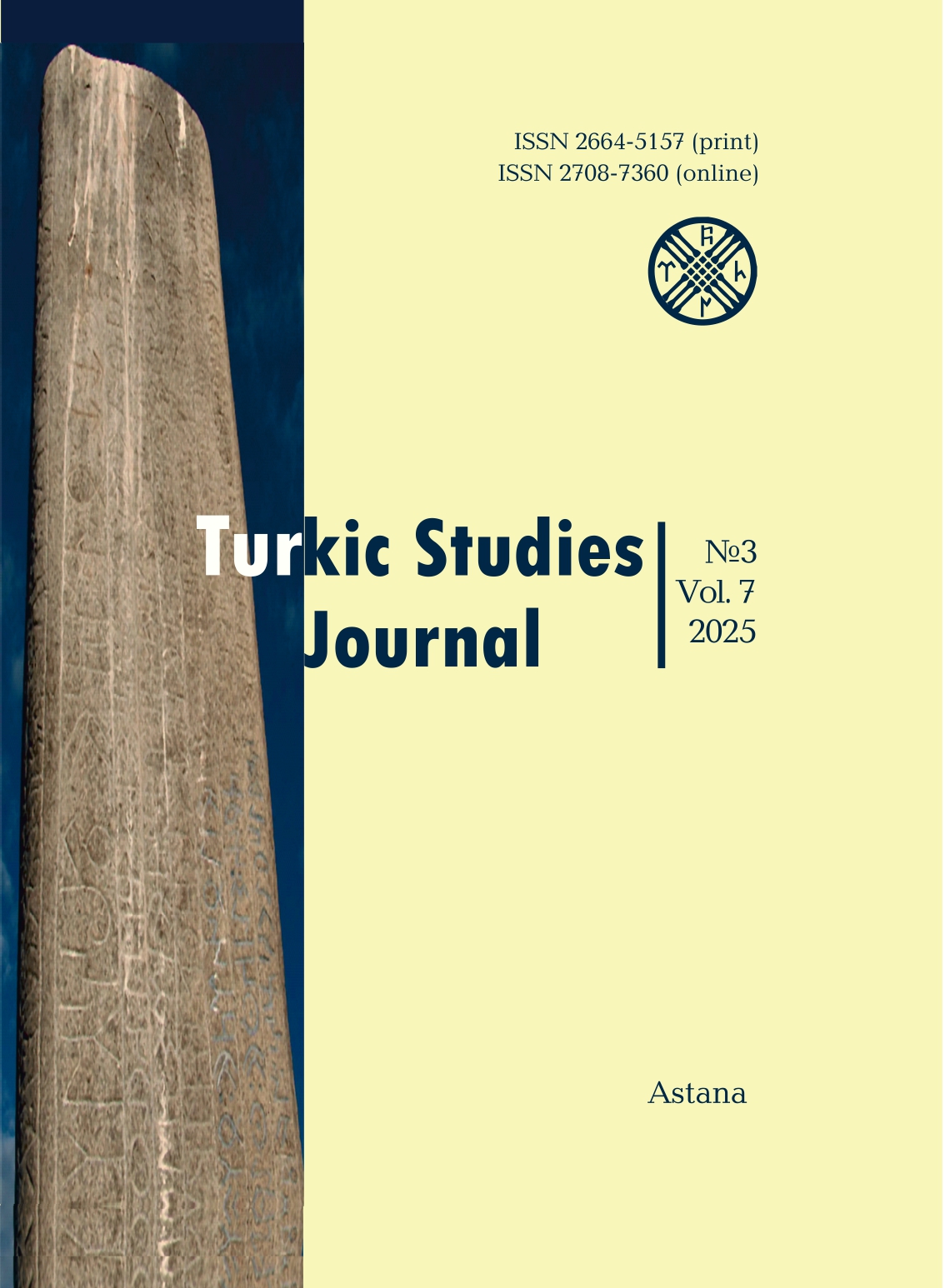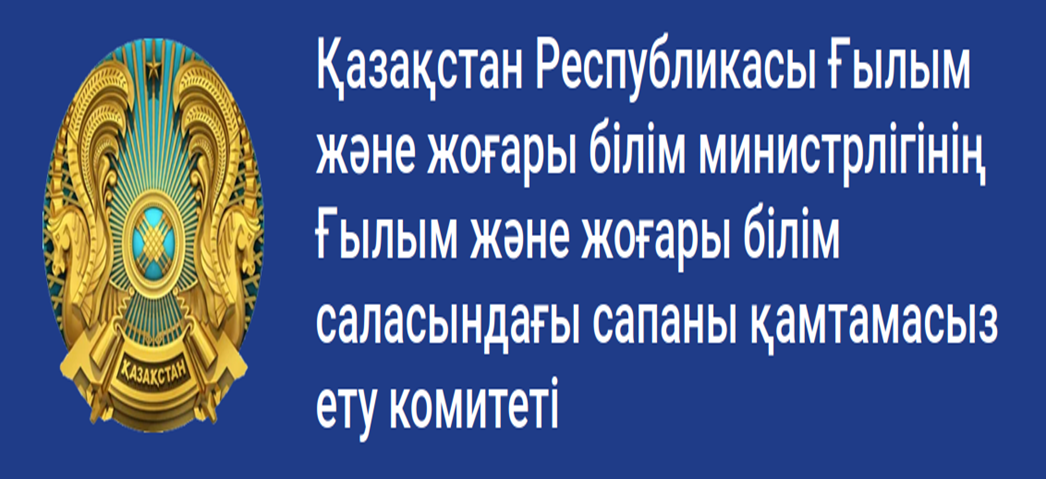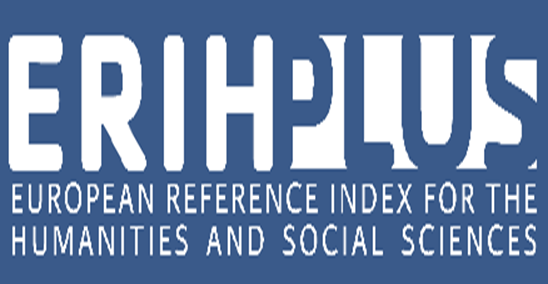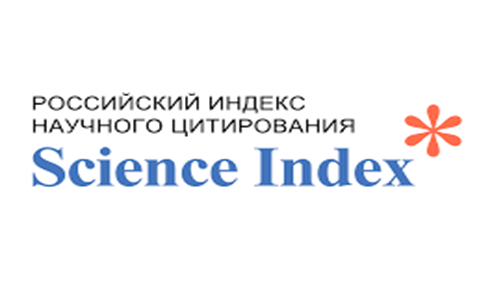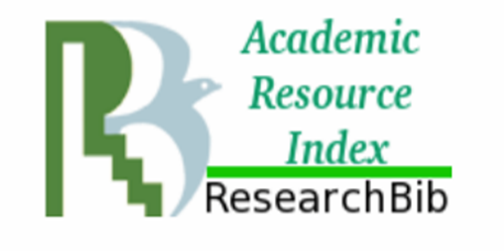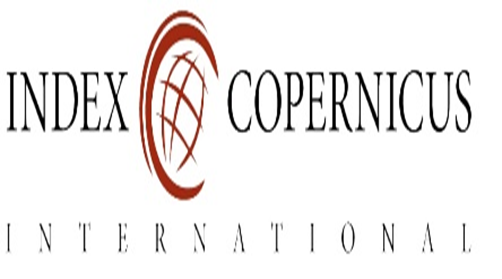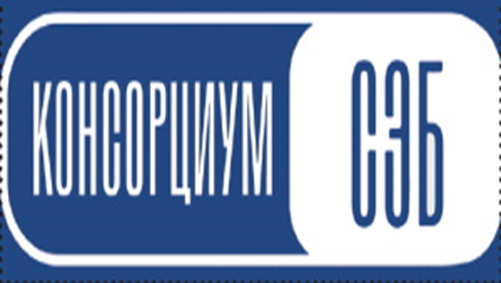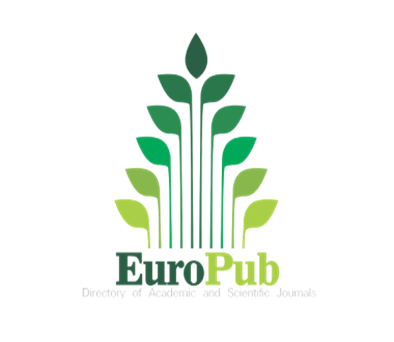On the word bolmačï in Turkic Languages
Views: 201 / PDF downloads: 3
DOI:
https://doi.org/10.32523/2664-5157-2025-3-228-241Keywords:
Early Middle Turkic texts, bolmačï, diversity of meanings, modern Turkic languages, Kazakh, Karachay-Balkar, Urum, morphemic structure of the word, suffix -čï, lexicalization of grammatical meaningAbstract
This article analyzes the word bolmačï, which is rarely attested in Early Middle Turkic texts and has been overlooked by scholars until now. This word has multiple meanings, which are sometimes contradictory, including 'impossible, futile, vain, unnecessary, insignificant' and 'to be, to exist'. The study aims to trace the word's semantic range in historical and modern Turkic languages, identify its dominant meaning and analyze its morphemic structure.The analysis is organized into three parts. The first part compiles all occurrences of bolmačï from historical texts of the Karakhanid, Khwarezmian, and Kipchak periods, analyzing the meanings of the lexeme, which are predominantly context-dependent. Furthermore, the interpretations of these meanings proposed by various scholars are reviewed, and the author offers alternative interpretations in cases where the existing explanations do not correspond to the sentence context. The second part investigates the meanings of bolmačï in modern Turkic languages. To determine the dominant meaning and lexical[1]semantic variants of the word, explanatory dictionaries of various Turkic languages are consulted. The study finds that the lexeme remains widely used in various forms in Kazakh (bolmačï), Karachay-Balkar (bolmačï), and Urum (bolmačï). In modern Turkic languages, the lexical meaning of the word varies: 'small', 'few', 'insignificant', 'meaningless', 'empty', 'futile', 'worthless', 'insufficient', 'unnecessary', 'negative', and 'false', among others. The lexical-semantic variants also shift depending on the context. The third part of the study analyzes the morphemic structure of bolmačï, consisting of the root stem bol- (‘to be’) + -ma (a formative negation affix) + -čï (a derivational affix). Particular attention is paid to the semantic transformation of the suffix -čï, whose origin and grammatical function remain the subject of scholarly debate. Summarizing various academic viewpoints, the author argues that -čï was forms. Throughout the historical development of the Turkic languages, this affix underwent lexicalisation, acquiring a derivational function in the process.In the conclusion, the author notes observes that bolmačï currently functions as an independent adjective and should be included in Turkic dictionaries as a nominative lexical entry.
Downloads
Reference
Гаркавец А., 2002. Кыпчакское письменное наследие. том І. Каталог и тексты памятников армянским письмом. Алматы: Дешт-и Кыпчак. 1084 с.
Гаркавец А., 2010. Кыпчакское письменное наследие. Tом ІIІ. Кыпчакский словарь по армянописным памятникам XVI-XVII веков. Алматы: Баур-Касеан. 1802 с.
Насилов Д.М., 2016. Заметки о показателе «глагольное имя + -čï» в истории тюркских языков. Тюркские языки 20. С. 179-185.
Argunşah M. & Güner, G., 2015. Codex Cumanicus. İstanbul: Kesit Yayınları. 1079 p.
Ata A., 1997. Ḳıṣaṣü’l-Enbiyā (Peygamber Kıssaları) I. Ankara: Türk Dil Kurumu Yayınları. 616 p.
Barutçu S., 2001. Türkçede enklitik edatlar üzerine: çI / çU. Kök Araştırmalar Dergisi 2. P. 75-86.
Berta Á., 1996. Deverbale wortbildung im Mittelkiptschakisch-Türkischen. Wiesbaden: Harrassowitz Verlag. 698 p.
Boeschoten H., 2022. A dictionary of Early Middle Turkic. Boston: Brill. 596 p. DOI: https://doi.org/10.1163/9789004525191
Eraslan K., 2012. Eski Uygur Türkçesi grameri. Ankara: Türk Dil Kurumu Yayınları. 664 р.
Erdal M., 2004. A Grammar of Old Turkic. Boston: Brill. 575 p. DOI: https://doi.org/10.1163/9789047403968
Gabain A., 1959. Die Sprache des Codex Cumanicus. In: Deny, Jean & Grønbech, Kaare & Scheel, Helmuth & Togan, Zeki Velidi (eds.) Philologiae Turcicae Fundamenta 1. Р. 46-73.
Aquis Mattiacis: Steiner.
Garkavets A., 2000. Urumskiy Slovnik. Alma-Ata: Baur. 631 p.
Grønbech K., 1942. Komanisches wörterbuch: Türkischer wortindex zu Codex Cumanicus. Copenhagen: Einar Munksgaard. 315 p.
Guzelanï Ž. & Ahmatlanï İ. & Žappulanï A., (eds.) 1996. Ḳaračay-Malḳar Tilni Aŋïlatma sözlügü. Nalʻčik: El-Fa. Vol. 1. 1022 p.
Karamanlıoğlu A., 1994. Kıpçak Türkçesi grameri. Ankara: Türk Dil Kurumu. 164 p.
Kuun C.G., 1880. Codex Cumanicus, bibliothecæ Ad Templum Divi Marci Venetiarum. Primum Ex Integro Editit Prolegomenis Notis Et Compluribus Glossariis Instruxit Comes Géza Kuun. Budapestini: Editio Scient Academiæ Hung. 398 p.
Schinkewitz J., 1947. Rabàÿzì sentaksı [Rabàÿzì syntax], (Trans. Sabit S. Paylı). İstanbul: İbrahim Horoz Basımevi. 122 p.
Süyerḳụlova, B. & Žanụzaḳ, T. & Žụbaeva, O., (eds.) 2011. Ḳazaḳ Ädebi Tịlịnịŋ Sözdịgị.
Almaty: Ḳazaḳstan respublikasï bịlịm ǰȧne γïłị̈ ŋm ministịrlịgị & A. Bawutursïnułï atïndaγï ̣tị̣l bịlịmị institutï. Vol. 3. 744 p.
Tekin Ş., 1992. “Eski Türkçe”. Türk Dünyası El Kitabı. Ankara: Türk Kültürünü Araştırma Enstitüsü Yayınları.
Tekin T., 1968. A grammar of Orkhon Turkic, Bloomington: India Universitey. 419 p.
Tekin T., 2003. Orhon Türkçesi grameri. İstanbul: Türk Dilleri Araştırmaları Dizisi: 9. 272 p.
Toparlı R., 1992. Iršād al-mulūk wa's-salāṭin. Ankara: Türk Dil Kurumu. 627 p.
Ünlü S., 2012. Harezm Altınordu Türkçesi sözlüğü. Konya: Eğitim Yayınevi. 716 p.
Ünlü S., 2018. Karahanlı Türkçesi ilk Türkçe satır-altı transkribeli Kur'an tercümesi TİEM 73, Türkiye Türkçesi mealli karşılaştırmalı Kur'ân-ı Kerîm. Konya: Selçuklu Belediyesi Yayınları. 450 р.
Zajączkowski A., 1961. Najstarsza wersja Turecka Ḫusräv u Şīrīn Quṭba III. 3 Vols., Warszawa: Państwowe Wydawnictwo Naukowe.
Reference
Garkavets A., 2002. Kypčakskoe pisʻmennoe nasledie. tom І. Katalog i Teksty Pamjatnikov Armjanskim Pisʻmom [Qypchaq written heritage. Volume I. catalogue and texts of monuments written in Armenian script]. Almaty: Dešt-i Kypčak. 1084 p. [in Russian].
Garkavets A., 2010. Kypčakskoe pisʻmennoe nasledie. tom ІIІ. Kypčakskii Slovarʻ. Po Armjanopisʻmennym Pamjatnikam XVI-XVII Vekov. [Qypchaq written heritage. volume III. Qypchaq dictionary on memorials of XVI-XVII centuries written by Armenian script]. Almaty: Baur – Kasean. 1802 p. [in Russian].
Nasilov D.M., 2016. Zametki o Pokazatele “Glagol'noe İmja + -čï” v İstorii Tjurkskich Jaz'kov, [Remarks on the formative of consisting of “a verbal noun and -čï” in the history of Turkic languages] Turkic languages 20. P. 179-185. [in Russian]. DOI: https://doi.org/10.13173/TL/2016/2/179
Argunşah M. & Güner, G., 2015. Codex Cumanicus. İstanbul: Kesit Yayınları. 1079 p. [in Turkish].
Ata A., 1997. Ḳıṣaṣü’l-Enbiyā (Peygamber Kıssaları) I. [The stories of the prophets], Ankara: Türk Dil Kurumu Yayınları. 616 p. [in Turkish].
Barutçu S., 2001. Türkçede enklitik edatlar üzerine: çI / çU [On the Turkish enclitics: çI / çU]. Kök Araştırmalar Dergisi 2. P. 75-86. [in Turkish].
Berta Á., 1996. Deverbale wortbildung im Mittelkiptschakisch-Türkischen [Deverbal word formation in Middle Kipchak Turkic]. Wiesbaden: Harrassowitz Verlag. 698 p. [in German].
Boeschoten H., 2022. A dictionary of Early Middle Turkic. Boston: Brill. 596 p.Eraslan K., 2012. Eski Uygur Türkçesi grameri [A grammar of Old Uygur Turkic]. Ankara: Türk Dil Kurumu Yayınları. 664 p. [in Turkish].
Erdal M., 2004. A Grammar of Old Turkic. Boston: Brill. 575 p.Gabain, A., 1959. Die Sprache des Codex Cumanicus [The language of Codex Cumanicus]. In: Deny, Jean & Grønbech, Kaare & Scheel, Helmuth & Togan, Zeki Velidi (eds.) Philologiae Turcicae Fundamenta 1. Р. 46-73. Aquis Mattiacis: Steiner. [in German].
Garkavets A., 2000. Urumskiy Slovnik [A dictionary of Urum]. Alma-Ata: Baur. 631 p. [in Russian].
Grønbech K., 1942. Komanisches wörterbuch: Türkischer wortindex zu Codex Cumanicus [Koman dictionary: Turkic word index for Codex Cumanicus]. Copenhagen: Einar Munksgaard. 315 p. [in German].
Guzelanï Ž. & Ahmatlanï İ. & Žappulanï A., (eds.) 1996. Ḳaračay-Malḳar Tilni Aŋïlatma sözlügü [Comprehensive dictionary of Karachay-Malkar language]. Nalʻčik: El-Fa. Vol. 1. 1022 p. [in Karachay Balkar].
Karamanlıoğlu A., 1994. Kıpçak Türkçesi grameri [A grammar of Kipchak Turkic]. Ankara: Türk Dil Kurumu. 164 p. [in Turkish].
Kuun C.G., 1880. Codex Cumanicus, bibliothecæ Ad Templum Divi Marci Venetiarum. Primum Ex Integro Editit Prolegomenis Notis Et Compluribus Glossariis Instruxit Comes Géza Kuun. Budapestini: Editio Scient Academiæ Hung. 398 p. [in Latin].
Schinkewitz J., 1947. Rabàÿzì sentaksı [Rabàÿzì syntax], (Trans. Sabit S. Paylı). İstanbul: İbrahim Horoz Basımevi. 122 p. [in Turkish].
Süyerḳụlova, B. & Žanụzaḳ, T. & Žụbaeva, O., (eds.) 2011. Ḳazaḳ Ädebi Tịlịnịŋ Sözdịgị [A dictionary of Kazakh literary language]. Almaty: Ḳazaḳstan respublikasï bịlịm ǰȧne γïłị̈ ŋm ministịrlịgị & A. Bawutursïnułï atïndaγï ̣tị̣l bịlịmị institutï [Ministry of Education and ̣Science of the Republic of Kazakhstan & Ahmet Bawutursïnułï Language Institution]. Vol. 3. 744 p. [in Kazakh].
Tekin Ş., 1992. “Eski Türkçe” [Old Turkic]. Türk Dünyası El Kitabı. Ankara: Türk Kültürünü Araştırma Enstitüsü Yayınları. [in Turkish].
Tekin T., 1968. A grammar of Orkhon Turkic, Bloomington: India Universitey. 419 p. Tekin T., 2003. Orhon Türkçesi grameri [A grammar of Orkhon Turkic]. İstanbul: Türk Dilleri Araştırmaları Dizisi: 9. 272 p. [in Turkish].
Toparlı R., 1992. Iršād al-mulūk wa's-salāṭin [The guidance of the kings and sultans]. Ankara: Türk Dil Kurumu. 627 p. [in Turkish].
Ünlü S., 2012. Harezm Altınordu Türkçesi sözlüğü [A dictionary of Khwarezm and Golden Horde Turkic]. Konya: Eğitim Yayınevi. 716 p. [in Turkish].
Ünlü S., 2018. Karahanlı Türkçesi ilk Türkçe satır-altı transkribeli Kur'an tercümesi TİEM 73, Türkiye Türkçesi mealli karşılaştırmalı Kur'ân-ı Kerîm [The first interlinear translition of the Qur'an in Karakhanid Turkic, Comparative Quran with Türkiye Turkish meaning]. Konya: Selçuklu Belediyesi Yayınları. 450 p. [in Turkish].
Zajączkowski A., 1961. Najstarsza wersja Turecka Ḫusräv u Şīrīn Quṭba III [The oldest Turkic version of Khusraw and Shīrīn by Quṭb]. 3 vols., Warszawa: Państwowe Wydawnictwo Naukowe. [in Polish].
Downloads
Published
How to Cite
Issue
Section
License
Copyright (c) 2025 Turkic Studies Journal

This work is licensed under a Creative Commons Attribution-NonCommercial 4.0 International License.

